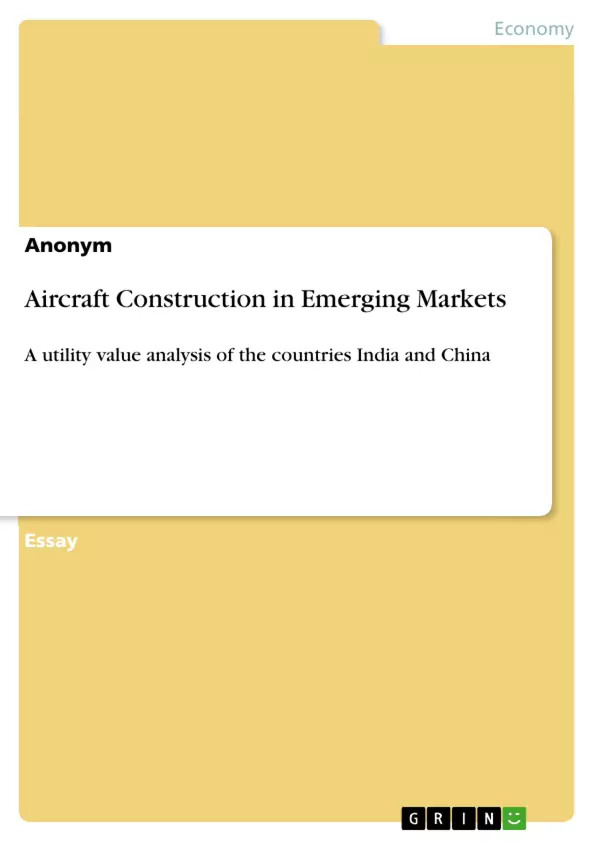The analysis of the aircraft construction programs in India and China is intended to show in which country and in which areas there is probably the greatest development potential for international competition in the medium term. This development potential will be illustrated with the help of a utility value analysis.
Quite a few people are fascinated by the grace of an ascending jumbo jet. Man-made, the aircraft weighing tons takes off with apparent lightness and brings us safely to our destination. Improved, enlarged and made safer in 100 years, millions of people use it daily to get from A to B. In only 8 hours from Frankfurt to New York or Mumbai, it makes it easier not only for tourists to travel, but also for business people from multinational companies to reach other continents in a very short time. Especially in the globalized world in which we live, it is not possible more can be dispensed with. The gradual removal of trade barriers and thus The emergence of large domestic markets further enlarges this economic network and leads to new suppliers being found and production being outsourced. This happens especially in an industry with such a large value chain as in aircraft construction.
Inhaltsverzeichnis (Table of Contents)
- Introduction
- Aim
- Approach
- Essentials
- Aircraft construction industry
- Future challenges for the aircraft construction industry
- Competencies in aircraft construction
- India
- China
- Risks in aircraft constructions
- India
- China
- Utility Value Analysis
Zielsetzung und Themenschwerpunkte (Objectives and Key Themes)
This analysis of aircraft construction programs in India and China aims to identify which country and areas hold the most significant development potential for international competition in the medium term. A utility value analysis will be used to illustrate this potential.
- Analyzing the development potential of aircraft construction programs in India and China
- Identifying areas of potential international competition
- Utilizing a utility value analysis to assess potential
- Exploring the key competencies and risks of India and China in aircraft construction
- Examining the future challenges faced by the aircraft construction industry
Zusammenfassung der Kapitel (Chapter Summaries)
- Introduction: This chapter introduces the topic of aircraft construction and its significance in the globalized world. It highlights the increasing demand for air travel and the role of the aircraft construction industry in meeting this demand.
- Essentials: This chapter provides a fundamental overview of the aircraft construction industry. It discusses the industry's key features, its value chain, and the future challenges it faces.
- Competencies in aircraft construction: This chapter focuses on the strengths and capabilities of India and China in the aircraft construction sector. It analyzes the existing infrastructure, technological advancements, and human capital in each country.
- Risks in aircraft constructions: This chapter examines the potential risks and challenges associated with aircraft construction in India and China. It explores factors such as regulatory frameworks, technological hurdles, and economic stability.
- Utility Value Analysis: This chapter presents a detailed analysis of the utility value of aircraft construction in India and China. It compares the strengths, weaknesses, opportunities, and threats of both countries, providing insights into their competitive positions.
Schlüsselwörter (Keywords)
The key focus of this analysis is on the aircraft construction industry, particularly in India and China. This includes the analysis of competencies, risks, and development potential within the context of international competition. The utility value analysis serves as a crucial tool in assessing these aspects, highlighting key themes such as globalized markets, international supply chains, and the role of technology in shaping the future of the industry.
- Quote paper
- Anonym (Author), 2020, Aircraft Construction in Emerging Markets, Munich, GRIN Verlag, https://www.grin.com/document/1004830



